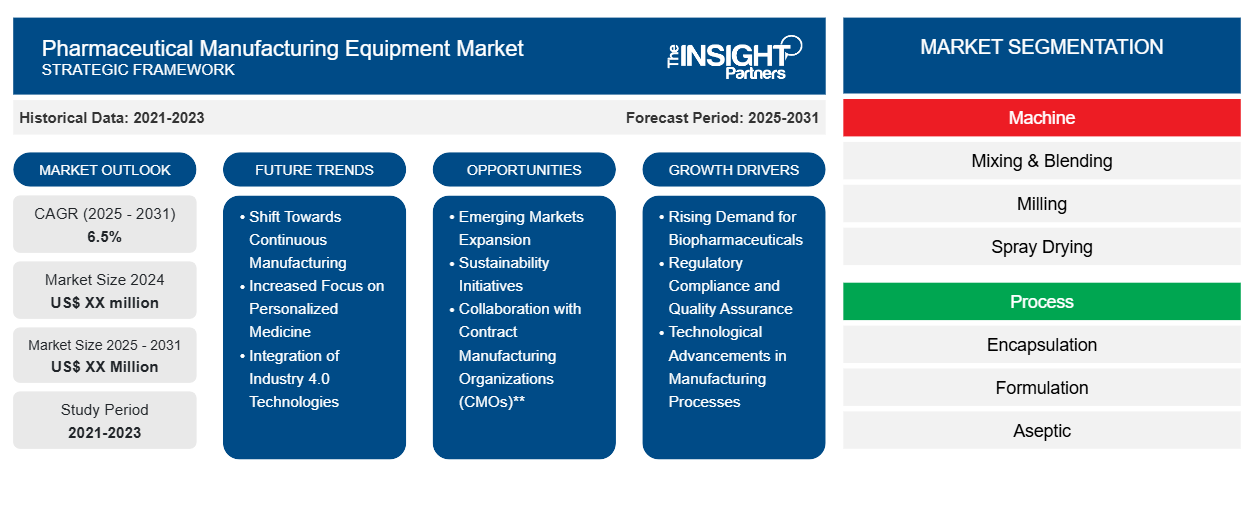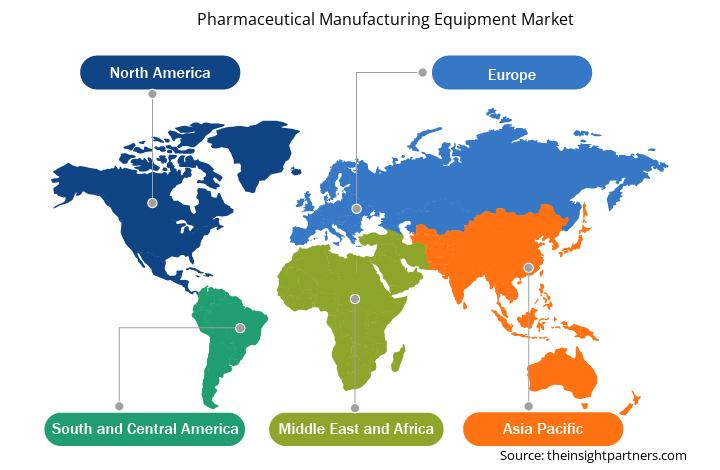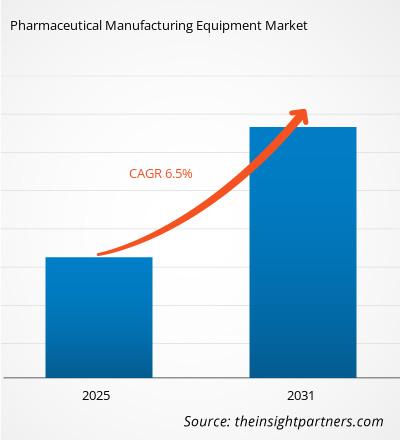من المتوقع أن يسجل سوق معدات تصنيع الأدوية معدل نمو سنوي مركب بنسبة 6.5٪ من عام 2025 إلى عام 2031، مع توسع حجم السوق من XX مليون دولار أمريكي في عام 2024 إلى XX مليون دولار أمريكي بحلول عام 2031.
تم تقسيم التقرير حسب الآلة (الخلط والمزج، الطحن، التجفيف بالرش، التحبيب، البثق، ضغط الأقراص، التعقيم، والتفتيش)، والعملية (التغليف، الصياغة، والتعقيم).
غرض التقرير
يهدف تقرير "سوق معدات تصنيع الأدوية" الصادر عن شركة "ذا إنسايت بارتنرز" إلى وصف المشهد الحالي والنمو المستقبلي، وأهم العوامل المحفزة، والتحديات، والفرص المتاحة. وسيوفر هذا التقرير رؤى ثاقبة لمختلف أصحاب المصلحة في قطاع الأعمال، مثل:
- مزودي التكنولوجيا/المصنعين: لفهم ديناميكيات السوق المتطورة ومعرفة فرص النمو المحتملة، وتمكينهم من اتخاذ قرارات استراتيجية مستنيرة.
- المستثمرون: إجراء تحليل شامل للاتجاهات فيما يتعلق بمعدل نمو السوق، والتوقعات المالية للسوق، والفرص المتاحة عبر سلسلة القيمة.
- الهيئات التنظيمية: لتنظيم السياسات ومراقبة الأنشطة في السوق بهدف تقليل الانتهاكات والحفاظ على ثقة المستثمرين ودعم سلامة السوق واستقرارها.
تجزئة سوق معدات تصنيع الأدوية
آلة
- الخلط والمزج
- الطحن
- التجفيف بالرش
- تحبيب
- البثق
- ضغط الجهاز اللوحي
- تعقيم
- تقتيش
عملية
- التغليف
- صياغة
- معقم
قم بتخصيص هذا التقرير ليناسب متطلباتك
ستحصل على تخصيص لأي تقرير - مجانًا - بما في ذلك أجزاء من هذا التقرير، أو تحليل على مستوى الدولة، وحزمة بيانات Excel، بالإضافة إلى الاستفادة من العروض والخصومات الرائعة للشركات الناشئة والجامعات
سوق معدات تصنيع الأدوية: رؤى استراتيجية

- احصل على أهم اتجاهات السوق الرئيسية لهذا التقرير.ستتضمن هذه العينة المجانية تحليل البيانات، بدءًا من اتجاهات السوق وحتى التقديرات والتوقعات.
عوامل نمو سوق معدات تصنيع الأدوية
- الطلب المتزايد على المستحضرات الصيدلانية الحيوية: يُسهم الانتشار المتزايد للأمراض المزمنة وشيخوخة السكان في زيادة الطلب على المستحضرات الصيدلانية الحيوية، والتي تتطلب معدات تصنيع متخصصة. ولأن المستحضرات الصيدلانية الحيوية غالبًا ما تنطوي على عمليات إنتاج معقدة، فإن الحاجة إلى معدات متطورة قادرة على التعامل مع هذه التعقيدات أمرٌ أساسي. يدفع هذا التوجه مُصنّعي الأدوية إلى الاستثمار في أحدث المعدات لضمان إنتاج فعال ومتوافق مع المعايير لهذه العلاجات المبتكرة.
- الامتثال التنظيمي وضمان الجودة: تُعدّ المتطلبات التنظيمية الصارمة التي تفرضها الجهات الصحية، مثل إدارة الغذاء والدواء الأمريكية (FDA) ووكالة الأدوية الأوروبية (EMA)، دافعًا رئيسيًا لسوق معدات تصنيع الأدوية. يجب على المصنّعين ضمان استيفاء معداتهم لأعلى معايير الجودة والسلامة، مما يؤدي إلى زيادة الاستثمارات في التقنيات المتقدمة التي تُسهّل الامتثال. ويشمل ذلك المعدات التي تدعم إمكانية التتبع والتحقق والمراقبة الآنية، وهي أمور بالغة الأهمية للحفاظ على سلامة المنتج وتلبية التوقعات التنظيمية.
- التطورات التكنولوجية في عمليات التصنيع: تشهد صناعة الأدوية تطورات تكنولوجية متسارعة، تشمل الأتمتة، وتكنولوجيا تحليل العمليات (PAT)، والرقمنة. تُعزز هذه الابتكارات كفاءة التصنيع، وتُخفض تكاليف الإنتاج، وتُحسّن جودة المنتج. ومع سعي الشركات لتحقيق التميز التشغيلي والمرونة في عمليات التصنيع، يتزايد الطلب على المعدات الحديثة التي تُدمج هذه التقنيات، مما يُعزز نمو السوق.
اتجاهات مستقبل سوق معدات تصنيع الأدوية
- التحول نحو التصنيع المستمر: يشهد قطاع الصناعات الدوائية توجهًا ملحوظًا نحو عمليات التصنيع المستمر، مبتعدًا عن الإنتاج التقليدي على دفعات. يوفر التصنيع المستمر مزايا عديدة، منها اختصار أوقات الإنتاج، وانخفاض التكاليف، وتحسين ثبات المنتج. يدفع هذا التحول المصنّعين إلى الاستثمار في معدات متخصصة مصممة للعمليات المستمرة، مما يُحدث نقلة نوعية في قطاع تصنيع الأدوية.
- زيادة التركيز على الطب الشخصي: يؤثر تنامي الطب الشخصي على سوق معدات تصنيع الأدوية. فمع تزايد تخصيص العلاجات لاحتياجات المرضى الفردية، يحتاج المصنعون إلى معدات مرنة وقابلة للتكيف، قادرة على التعامل مع أحجام دفعات صغيرة وتركيبات متنوعة من المنتجات. ويدفع هذا التوجه عجلة الابتكار في تصميم المعدات ووظائفها، مما يُمكّن المصنعين من الاستجابة بسرعة لمتطلبات السوق المتغيرة والعلاجات المخصصة للمرضى.
- دمج تقنيات الصناعة 4.0: يُحدث اعتماد تقنيات الصناعة 4.0، مثل إنترنت الأشياء والذكاء الاصطناعي وتحليلات البيانات الضخمة، تحولاً جذرياً في صناعة الأدوية. تُمكّن هذه التقنيات من المراقبة الآنية والصيانة التنبؤية وتعزيز قدرات اتخاذ القرار. ومع سعي المُصنّعين لتحسين عملياتهم ورفع كفاءتهم، يزداد دمج هذه التقنيات المتقدمة في معدات التصنيع انتشاراً، مما يُشكّل مستقبل هذه الصناعة.
فرص سوق معدات تصنيع الأدوية
- التوسع في الأسواق الناشئة: يتمتع سوق معدات تصنيع الأدوية بفرص نمو كبيرة في الأسواق الناشئة، حيث تتجلى بوضوح زيادة الاستثمارات في الرعاية الصحية وارتفاع الطلب على الأدوية. ومع قيام دول آسيا والمحيط الهادئ وأمريكا اللاتينية وأفريقيا بتطوير بنيتها التحتية للرعاية الصحية، تزداد الحاجة إلى معدات تصنيع حديثة. ويمكن للشركات التي تدخل هذه الأسواق بشكل استراتيجي الاستفادة من الطلب المتزايد على حلول تصنيع فعّالة ومتوافقة مع المعايير.
- مبادرات الاستدامة: يتزايد التركيز على الاستدامة في صناعة الأدوية، مما يتيح فرصًا لمصنعي المعدات لتطوير حلول صديقة للبيئة. يشمل ذلك الآلات الموفرة للطاقة، وتقنيات تقليل النفايات، والعمليات التي تقلل من الأثر البيئي. ونظرًا لأن شركات الأدوية تولي الاستدامة أولوية في عملياتها، فهناك طلب متزايد على المعدات التي تتوافق مع هذه المبادرات، مما يوفر فرصة مربحة للمصنّعين المبتكرين.
- التعاون مع منظمات التصنيع التعاقدي**: يُتيح التوجه نحو الاستعانة بمصادر خارجية لتصنيع المعدات من منظمات التصنيع التعاقدي فرصًا لموردي المعدات. وفي ظل سعي شركات الأدوية إلى خفض التكاليف وزيادة المرونة، فإنها تتعاون بشكل متزايد مع منظمات التصنيع التعاقدي التي تتطلب معدات تصنيع متطورة. ويتيح هذا التعاون لمصنعي المعدات توسيع نطاق وصولهم إلى السوق وتطوير حلول مُصممة خصيصًا لتلبية الاحتياجات المحددة لمنظمات التصنيع التعاقدي وعملائها.
رؤى إقليمية حول سوق معدات تصنيع الأدوية
قام محللو إنسايت بارتنرز بشرح شامل للاتجاهات والعوامل الإقليمية المؤثرة في سوق معدات تصنيع الأدوية خلال فترة التوقعات. ويناقش هذا القسم أيضًا قطاعات سوق معدات تصنيع الأدوية ومناطقها الجغرافية في أمريكا الشمالية، وأوروبا، وآسيا والمحيط الهادئ، والشرق الأوسط وأفريقيا، وأمريكا الجنوبية والوسطى.

- احصل على البيانات الإقليمية المحددة لسوق معدات تصنيع الأدوية
نطاق تقرير سوق معدات تصنيع الأدوية
| سمة التقرير | تفاصيل |
|---|---|
| حجم السوق في عام 2024 | XX مليون دولار أمريكي |
| حجم السوق بحلول عام 2031 | XX مليون دولار أمريكي |
| معدل النمو السنوي المركب العالمي (2025 - 2031) | 6.5% |
| البيانات التاريخية | 2021-2023 |
| فترة التنبؤ | 2025-2031 |
| القطاعات المغطاة | بواسطة الآلة
|
| المناطق والدول المغطاة | أمريكا الشمالية
|
| قادة السوق وملفات تعريف الشركات الرئيسية |
|
كثافة اللاعبين في سوق معدات تصنيع الأدوية: فهم تأثيرها على ديناميكيات الأعمال
يشهد سوق معدات تصنيع الأدوية نموًا سريعًا، مدفوعًا بتزايد طلب المستخدم النهائي نتيجةً لعوامل مثل تطور تفضيلات المستهلكين، والتقدم التكنولوجي، وزيادة الوعي بفوائد المنتج. ومع تزايد الطلب، تعمل الشركات على توسيع عروضها، والابتكار لتلبية احتياجات المستهلكين، والاستفادة من الاتجاهات الناشئة، مما يعزز نمو السوق.
تشير كثافة اللاعبين في السوق إلى توزيع الشركات العاملة في سوق أو قطاع معين. وتشير إلى عدد المنافسين (اللاعبين في السوق) الموجودين في سوق معين نسبةً إلى حجمه أو قيمته السوقية الإجمالية.
الشركات الرئيسية العاملة في سوق معدات تصنيع الأدوية هي:
- شركة جي إي إيه جروب المساهمة
- IMA INDUSTRIA MACHINE AUTOMATICHE SPA
- شركة سينتيجون للتكنولوجيا المحدودة
- ايه سي جي
- شركة ثيرمو فيشر العلمية
- مجموعة روماكو
إخلاء المسؤولية : الشركات المذكورة أعلاه ليست مرتبة بأي ترتيب معين.

- احصل على نظرة عامة على أهم اللاعبين الرئيسيين في سوق معدات تصنيع الأدوية
نقاط البيع الرئيسية
- التغطية الشاملة: يغطي التقرير بشكل شامل تحليل المنتجات والخدمات والأنواع والمستخدمين النهائيين لسوق معدات تصنيع الأدوية، مما يوفر مشهدًا شاملاً.
- تحليل الخبراء: تم تجميع التقرير على أساس الفهم العميق لخبراء الصناعة والمحللين.
- معلومات محدثة: يضمن التقرير أهمية الأعمال التجارية بسبب تغطيته للمعلومات الحديثة واتجاهات البيانات.
- خيارات التخصيص: يمكن تخصيص هذا التقرير لتلبية متطلبات العملاء المحددة وتلبية استراتيجيات العمل بشكل مناسب.
لذا، يُمكن لتقرير البحث حول سوق معدات تصنيع الأدوية أن يُساعد في تمهيد الطريق لفهم سيناريوهات الصناعة وآفاق نموها. ورغم وجود بعض المخاوف المُبررة، إلا أن فوائد هذا التقرير الإجمالية تفوق عيوبه.
- التحليل التاريخي (سنتان)، سنة الأساس، التوقعات (7 سنوات) مع معدل النمو السنوي المركب
- تحليل PEST و SWOT
- حجم السوق والقيمة / الحجم - عالمي، إقليمي، بلد
- الصناعة والمنافسة
- مجموعة بيانات إكسل
التقارير الحديثة
تقارير ذات صلة
شهادات العملاء
سبب الشراء
- اتخاذ قرارات مدروسة
- فهم ديناميكيات السوق
- تحليل المنافسة
- رؤى العملاء
- توقعات السوق
- تخفيف المخاطر
- التخطيط الاستراتيجي
- مبررات الاستثمار
- تحديد الأسواق الناشئة
- تحسين استراتيجيات التسويق
- تعزيز الكفاءة التشغيلية
- مواكبة التوجهات التنظيمية




















 احصل على عينة مجانية ل - سوق معدات تصنيع الأدوية
احصل على عينة مجانية ل - سوق معدات تصنيع الأدوية